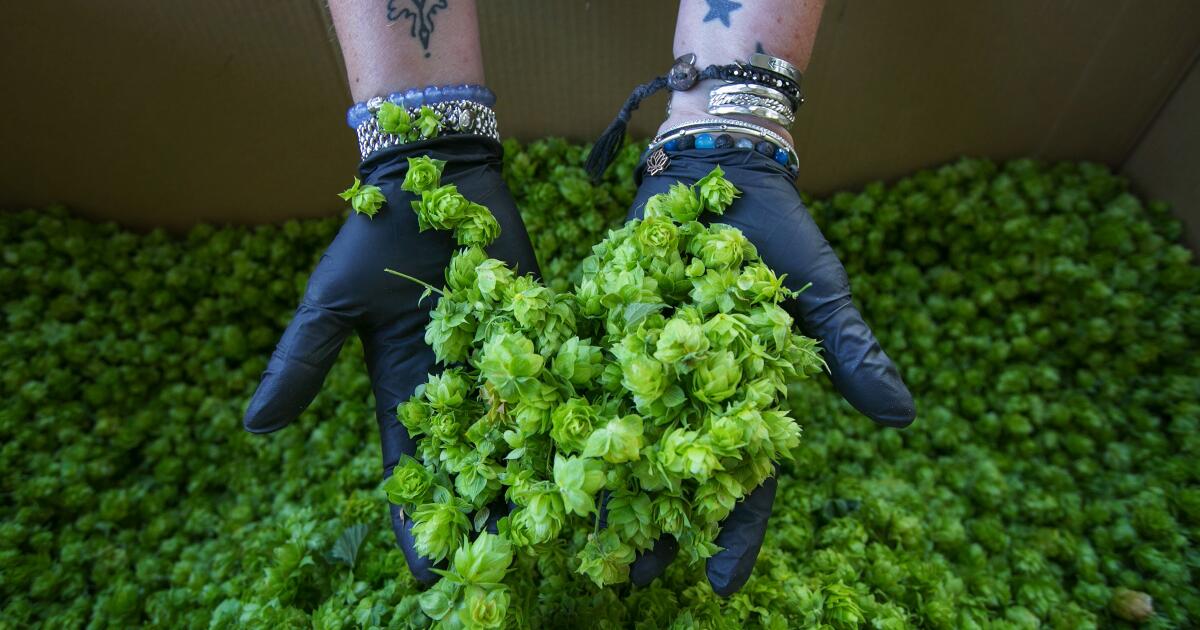
Not long ago, enthusiasts foresaw a day when many San Diego beers would feature San Diego hops, the oily cones that lend beer numerous enticing flavors and aromas.
When the San Diego Hop Growers Association opened in 2015, its members represented farms in Fallbrook, Valley Center, Ramona, Julian, even Baja California’s Valle de Guadalupe.
“Hops aren’t that hard to grow,” Phil Warren, a retired teacher told me in 2019, while harvesting several varieties in Julian. “They will grow most anywhere you have hot summers and some chill.”
There was a vision of hop vines sprouting across the county. But was this really a mirage?
Today, the growers’ association is moribund and its co-founders, Lyle Kafader and Eric March, are both out of the business. Kafader and her husband sold their farm, Fallbrook’s ZP Growers, to Nopalito Farms & Hopyard — and Nopalito abandoned that crop in 2020.
Ramona’s Star B Ranch, where March started raising hops in 2008, is for sale. Its three acres of hop vines, always a small part of the 1,260-acre estate, went unharvested this year.

“Magnum” hops on the vine at Star B Ranch and hop farm in 2019.
(John Gibbins/The San Diego Union-Tribune)
San Diego Golden Hop Farm in Fallbrook? “We’re no longer in business,” said co-owner Corie Johndro.
Hammer’s Hops in Ramona? Owner Max D’Agostino sold in 2021.
Warren, the retired teacher who has run Julian’s Hopportunity Farms for 15 years?
“I’m still growing hops,” he said in September, “although that may be coming to an end pretty soon here.”
Several factors hinder San Diego County’s homegrown hop industry.
Hops are a thirsty plant, a problem in drought-plagued areas like ours.
Hops require more work than many other crops.
“Where we used to grow hops, we grow cut flowers,” said Jordan Brownwood, co-owner of Nopalito Farm in Valley Center. “It takes much less labor.”
The region’s little farms — none ever exceeded three acres — cannot compete with behemoths like Anheuser-Busch’s 1,700-acre Elk Mountain in Idaho.
“To make money at this you’d have to have acres and acres and acres of hops,” said Warren, who presides over 110 vines on a half-acre.
Even geography conspires against the local farmers. Hops love warm, sunny days — and those happen to be longer and hotter in the Pacific Northwest.
“Our yields are lower in San Diego County, maybe three or four pounds per plant,” Brownwood said. “Plants in Oregon, Washington and Idaho may yield up to 20 pounds.”
This June 15, a plea appeared on the Facebook page of the San Diego Hop Growers Association. Someone identified as the “creator/co-creator of this page” noted they were “years out of the industry and living a different life …
“If anyone wants to pick up the baton? I will have your back.”
There have been no further posts.
The Next Round

The Guild Fest event at San Diego Beer Week in November 2019.
(Jared Gase/ )
Nov. 3-12: The 2023 edition of San Diego Beer Week will include the expected beer dinners, tap takeovers, brewing classes and general revelry. But not two signature events you may have expected.
This year, there’s no Guild Fest, a party that had featured beers from dozens of area breweries, or the Beer Garden’s beer-and-food pairings held at The Lodge at Torrey Pines.
I hear both events may return in 2024.
Meanwhile, San Diego Brewers Guild President Erik Fowler promised to emphasize events at local breweries and tap rooms. The Guild’s board members also promise to be more visible, mingling with the public at local breweries and tap rooms.
“Hey, we are here,” said Kilowatt Brewing’s Esthela Davila, a board member. “Ask us a question.”
Beer Week events are listed at sdbeer.com.
Quick Sips

Shoots Beer’s Blonde Ale.
(Courtesy of Peter Rowe)
Beer: Blonde Ale
From: Shoots Beer, Carlsbad
ABV (Alcohol By Volume): 4.5 percent
Style: Cream Ale
Drink or dump: Drink. Not a dumb blonde, this cream ale is surprisingly refined. Smooth and light on the tongue, it uses flaked maize to sweeten the crisp bitterness of Cascade hops.

Dogleg Brewing’s Compadres Mexican lager.
(Courtesy of Peter Rowe)
Beer: Compadres
From: Dogleg Brewing, Vista
ABV: 5.2 percent
Style: Mexican Lager
Drink or dump: Drink. Despite a strong Doritos aroma, thanks to Compadres’ use of corn, lightly-toasted bready flavors predominate, leading to a lime-spritzed finish.

New Belgium Brewing’s Transatlantique Kriek.
(Courtesy of Peter Rowe)
Beer: Transatlantique Kriek
From: New Belgium Brewing, Fort Collins, Colo., and Oud Beersel, Beersel, Belgium
ABV: 5.2 percent
Style: Kriek
Drink or dump: Drink. For 20 years, New Belgium has imported Oud Beersel’s kriek, a sour cherry lambic, then blended it with its own sour golden ale. Transatlantique takes you on a first-class crossing, from tart and fruity opening to a bubbly midpalate and then a dry finish.
Rowe is a freelance writer.






